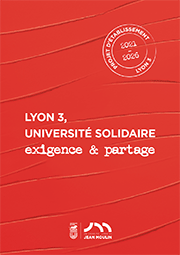AccueilRechercheProgrammes et productions scientifiquesThèsesThèses soutenuesThèses soutenues - 2023
-
Partager cette page
- Recherche,
JEAN-BAPTISTE Pascal
L’effectivité judiciaire interne de la convention américaine des droits de l’homme. Regards croisés des protections interaméricaine et constitutionnelle des droits et libertés en Amérique latine
Publié le 6 juillet 2023 – Mis à jour le 6 juillet 2023
Thèse en Droit, soutenue le 13 juin 2023.
Ce travail de recherche est consacré aux rapports entre les juridictions constitutionnelles nationales et la juridiction interaméricaine des droits de l’homme. Précisément, l’expression « effectivité judiciaire interne de la CADH », « effectivité par les juges », est adoptée pour mettre en évidence les enjeux et défis de l’interaméricanisation des ordres juridiques internes qui, sous l’angle du rôle des juges comme gardien des droits et libertés, ont comme amorce véritable la dernière vague de démocratisation de la région latino-américaine.
Cette effectivité judiciaire interne de la CADH rend compte de deux modèles de protection (en termes d’idéal-type), l’un animé par une logique d’intégration accentuée par le juge interaméricain et l’autre par une logique de coopération/concurrence liée aux comportements habituels des États dans leur rapport au droit international en général. Généralement, la doctrine explique la vigueur du droit de la CADH dans le droit interne, soit majoritairement sous le prisme de l’interaméricanisation par l’intégration, soit plus minoritairement par l’absence de cette interaméricanisation en mettant en avant, entre autres, le défaut structurel de certains ordres juridiques nationaux à faciliter la réalisation de la CADH. L’étude entreprise vise à démontrer que les deux modèles sus-indiqués ne peuvent se passer l’un de l’autre en termes de compréhension de l’effectivité judiciaire interne de la CADH. Dit autrement, la compréhension de cette effectivité doit tant à l’explication intégrative (propulsée d’en haut) qu’à l’explication ancrée dans la relativité des ordres juridiques internes. L’office du juge national à prendre en compte la CADH est ainsi régi de manière instable entre l’ordre interaméricain et les ordres nationaux. C’est la problématique de l’équilibre entre les deux modèles de protection : la balance a tendance, par moment, à pencher d’un côté ou de l’autre. Dans un incessant mouvement de va-et-vient, l’équilibre est condamné à une redéfinition en permanence.
L’étude cherche à mettre en évidence les présupposés stratégiques dont découle l’aspect dynamique des relations entre les juges nationaux et la Cour interaméricaine des droits de l’homme. L’analyse de l’ensemble vise à confirmer l’idée que l’évolution de la protection des droits et libertés repose sur des rapports de force entre les différentes juridictions concernées, tout en étant porteuse de perspectives communes.
Cette effectivité judiciaire interne de la CADH rend compte de deux modèles de protection (en termes d’idéal-type), l’un animé par une logique d’intégration accentuée par le juge interaméricain et l’autre par une logique de coopération/concurrence liée aux comportements habituels des États dans leur rapport au droit international en général. Généralement, la doctrine explique la vigueur du droit de la CADH dans le droit interne, soit majoritairement sous le prisme de l’interaméricanisation par l’intégration, soit plus minoritairement par l’absence de cette interaméricanisation en mettant en avant, entre autres, le défaut structurel de certains ordres juridiques nationaux à faciliter la réalisation de la CADH. L’étude entreprise vise à démontrer que les deux modèles sus-indiqués ne peuvent se passer l’un de l’autre en termes de compréhension de l’effectivité judiciaire interne de la CADH. Dit autrement, la compréhension de cette effectivité doit tant à l’explication intégrative (propulsée d’en haut) qu’à l’explication ancrée dans la relativité des ordres juridiques internes. L’office du juge national à prendre en compte la CADH est ainsi régi de manière instable entre l’ordre interaméricain et les ordres nationaux. C’est la problématique de l’équilibre entre les deux modèles de protection : la balance a tendance, par moment, à pencher d’un côté ou de l’autre. Dans un incessant mouvement de va-et-vient, l’équilibre est condamné à une redéfinition en permanence.
L’étude cherche à mettre en évidence les présupposés stratégiques dont découle l’aspect dynamique des relations entre les juges nationaux et la Cour interaméricaine des droits de l’homme. L’analyse de l’ensemble vise à confirmer l’idée que l’évolution de la protection des droits et libertés repose sur des rapports de force entre les différentes juridictions concernées, tout en étant porteuse de perspectives communes.
Mots-clés : Effectivité - Effectivité judiciaire - Effectivité judiciaire interne - Convention américaine des droits de l'homme - protection constitutionnelle des droits et libertés - Amérique latine - protection interaméricaine - système interaméricain des droits de l'homme - Cour interaméricaine des droits de l'homme - juge constitutionnel national – contrôle de conventionnalité.
This research work is devoted to the relationship between national constitutional jurisdictions and the inter-American jurisdiction of Human Rights. Specifically, the expression "internal judicial effectiveness of the ACHR", "effectiveness by judges", is adopted to highlight the issues and challenges of the inter-Americanisation of domestic legal orders. From the perspective of the judges’role as guardians of rights and freedoms, these issues and challenges have been triggered off by the latest wave of democratisation in the Latin American region.
The “ACHR internal judicial effectiveness” reflects two models of protection (in terms of ideal-type) : one is driven by a logic of integration accentuated by the inter-American judge while the other one is driven by a logic of cooperation/competition linked to the usual states’ behaviour regarding their relationship with international law in general. Generally, the doctrine explains the strength of ACHR law in domestic law, either mainly through the prism of inter-Americanisation by integration, or more rarely through the absence of this inter-Americanisation by putting forward, among other things, the structural failure of certain national legal orders to facilitate the ACHR achievements. The undertaken study aims at demonstrating that the two models mentioned above cannot do without each other in terms of understanding the ACHR internal judicial effectiveness. In other words, the understanding of this effectiveness owes as much to the integrative explanation (propelled from above) as to the explanation rooted in the relativity of domestic legal orders. The office for the national judge to take into account the ACHR is thus governed in an unstable manner by both the inter-American order and the national orders. That, is a problem of balance between the two models of protection: the scales tend, at times, to tip from one side to the other. In an incessant back and forth movement, the balance is condemned to a permanent redefinition.
The study seeks to highlight the strategic presuppositions from which derives the dynamic aspect of the relationship between national judges and the Inter-American Court of Human Rights. The analysis on the whole aims at confirming the idea of an evolution of the protection of rights and freedoms based on relations of power between the different jurisdictions involved, while carrying common perspectives at the same time.
Keywords: Effectiveness – Judicial effectiveness – Domestic judicial effectiveness – American Convention on Human Rights – Constitutional protection of rights and freedoms – Latin America – Inter-American protection – Inter-American human rights system – Inter-American Court of Human Rights – National constitutional judge – Control of conventionality
Directeur de thèse : Albane GESLIN
Membres du jury :
- Mme GESLIN Albane, Directrice de thèse, Professeur des universités, Science Po Lyon,
- Mme BURGORGUE-LARSEN Laurence, Rapporteure, Professeure des universités, l’Université Paris 1 Panthéon-Sorbonne,
- Mme MARTIN-CHENUT Kathia, Rapporteure, Directrice de recherche, CNRS institut des sciences juridiques et philosophique de la Sorbonne, Paris,
- Mme ARLETTAZ Jordane, Professeure des universités, Université de Montpellier,
- M. ROBERT Loïc, Maître de conférence, Université Jean Moulin Lyon 3.
- Mme BURGORGUE-LARSEN Laurence, Rapporteure, Professeure des universités, l’Université Paris 1 Panthéon-Sorbonne,
- Mme MARTIN-CHENUT Kathia, Rapporteure, Directrice de recherche, CNRS institut des sciences juridiques et philosophique de la Sorbonne, Paris,
- Mme ARLETTAZ Jordane, Professeure des universités, Université de Montpellier,
- M. ROBERT Loïc, Maître de conférence, Université Jean Moulin Lyon 3.
Président du jury : Jordane ARLETTAZ
Documentation
Mise à jour : 6 juillet 2023







